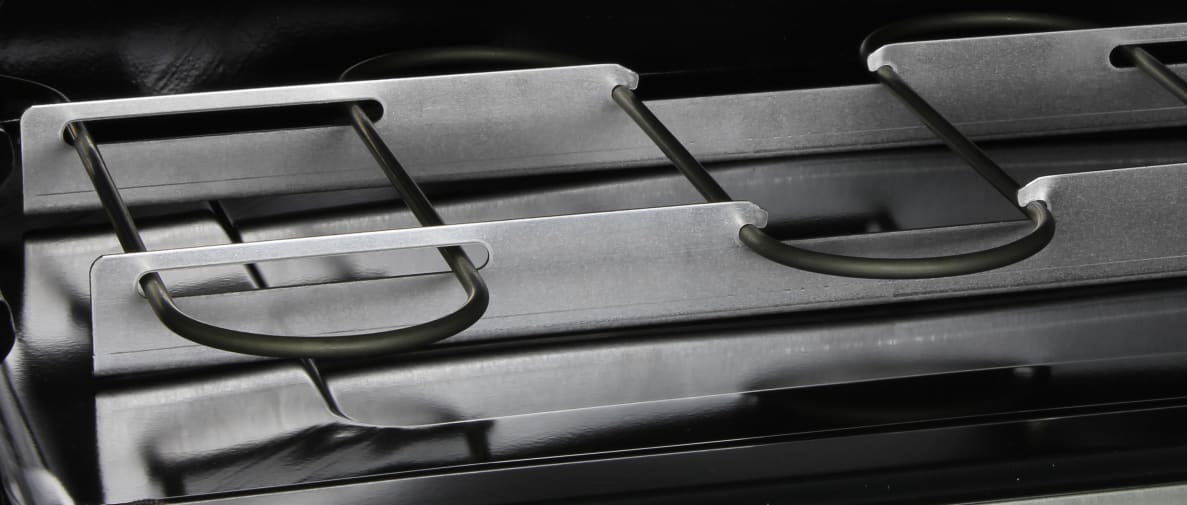Pros
Cons
The GE JB850SFSS (MSRP $1399) is one of the most affordable double-oven ranges on the market. For under $1,000 retail, you get a range with a great cooktop and two good ovens. Our only complaints are that it lacks convection, and that the ovens have difficulty with uniform baking.
You could always step up to the GE JB870SFSS, a nearly-identical range with convection, but it'll cost you an additional $400.
Design & Usability
{{section_header}}{{section.name}}{{/section_header}}
Lots of space, but no convection
If you’re going to spend less than $1,500 on a double oven electric range, it’s best not to expect too much design-wise. The JB850 certainly isn't fancy, but it's not at all unattractive. At first glance, the flash of stainless steel reels you in, but there just isn't very much of it. The backsplash and some small bits of trim have that nice finish, but the greater portion of the oven doors are finished in less-exciting shades of black and grey.
These colors are matched in the ceramic glass rangetop, which houses two dual-ring burners, two regular burners, and a central warming zone. The rangetop is controlled by knobs located on the backsplash. It’s relatively standard in this price range, and requires users to reach across a hot rangetop to adjust the temperature while cooking. Digital oven controls are also located on the backsplash.
{{ photo_gallery name="Real design & usability" }}
There aren't any speciality cooking modes or features on the JB850. That seems to be the trade-off for the fact that there are two ovens. Neither oven is capable of convection, but both can bake, warm, broil, and self-clean.
An impressive total oven capacity is this oven’s other selling point, with a 2.2 cubic-foot upper oven capacity and a 4.4 cubic-foot lower oven capacity totaling a spacious 6.6 cubic feet. The downside, of course, is that neither individual oven is particularly large. Of course there’s no need to fit both your Thanksgiving bird and a pan of sweet potatoes into one cavity when you can cook them separately in two.
Rangetop
{{section_header}}{{section.name}}{{/section_header}}
Excellent rangetop, with one too-hot burner
The double ovens may be the focal point of this range’s lineup, but the rangetop offers the most impressive performance. Most cooking zones were able to bring water to a boil in no time.
The outer rings of the two front dual-ring burners were especially speedy, with the front right 12-inch burner boiling six cups of water in slightly less than 4 minutes and the front left 9-inch burner coming in just over 5 minutes. The only burner that took unacceptably long to boil water was the left rear burner. Unless you’re planning to boil four pots at once, this rangetop has you covered.

The rangetop boiled water quickly and was capable of reaching both high and low temperatures.
Burners were also able to hit extremely high and low temperatures alike. Temperatures were as low as 124°F and as high as 843°F. The 843°F front left 9-inch cooking zone is actually hotter than we like to see. Users will have to watch out to make sure they don’t accidentally burn their food, and since that burner is near the front you should keep an eye out for safety.
Oven, Broiler, & Convection
{{section_header}}{{section.name}}{{/section_header}}
Unwanted heat burns innocent cookies!
There are only two things we love unconditionally about the JB850’s double ovens: Their lightning-fast preheats, and how quickly the lower oven’s broiler reached our target high temperature. Sadly, the upper oven’s broiler flunked our test by failing to reach the target high temperature during testing. Good thing most buyers rarely need to use two broilers at once.

The broiler in the lower oven heated up to 607°F in only about five minutes.
Our real world baking tests did not yield the results we had hoped for. Both cakes and cookies emerged with light tops and darker bottoms, all of which were darkest towards the corners of the oven. There was no saving the cookies, which had more intense browning variation than the cakes. Cakes were thankfully better off than the cookies, as the browning variation was less significant and happened uniformly from one cake to the next. The lower oven was a tad more successful in comparison to the upper, but still not perfect.
{{ photo_gallery name="Oven cavities" }}
It’s hard to compensate for browning issues that vary to this degree, so the best advice that we can give is that users try to bake their food as far away from the corners of the oven as possible. Rotating pans partway through the cook time may also help, and we recommend checking on your food before the cook time is up to avoid overcooking. These are tricky ovens, and you may not be able to expect perfection with them. They will, however, absolutely cook your food.
Before You Buy
{{section_header}}{{section.name}}{{/section_header}}
Two hot?
The GE JB850SFSS electric double oven range is a good, reasonably priced range with a few issues.
The rangetop was great, but we’re concerned about that one too-hot front burner. Lots of folks don’t use their convection mode (which should be remedied!), but we’d really miss it if our oven lacked this setting, which this GE does.
Most worrying: The ovens presented us with some pretty sorry cookies with no simple fix. Our bake test results showed both oven cavities get hot around the corners, and all we can suggest is that you attempt to bake food towards the center.
Simply put, this range is for those who really want the convenience of a double oven without shelling out too much extra cash. It’s not bad at all, especially when it comes to the rangetop—just don’t expect great oven performance.
From the Lab
We put our ranges through a series of rigorous tests to measure everything from how quickly they boil water to how evenly they bake cakes. The GE JB850SFSS scored well in some areas of our testing, and poorly in others.
Oven & Broiler Performance
The portion of our oven testing that we value most is our real world baking tests, where we put the ovens to work baking actual food and see how it does. In our cookie tests, we bake sugar cookies in the ovens and then measure the difference in browning between the cookie tops and bottoms, as well as the difference in browning from one cookie to another. In our cake tests, we take the same types of measurements as we do in our cookie tests, while also noting the degree to which different spots in the same cake vary in doneness, and ensure that our cakes rise evenly.
The GE JB850SFSS has two ovens—a smaller 2.2 cubic-foot upper oven and a larger 4.4 cubic-foot lower oven—so we tested the baking abilities of each oven. Neither did particularly well. When it came to our cookie test, both ovens turned out cookies with light tops and darker bottoms. This wouldn’t be a particularly big deal if this browning happened uniformly for every cookie in a single cavity, but in this case there appears to be a corner of each oven that is just too hot. Cookies emerged with light tops and darker bottoms, but these bottoms were darkest on one corner of each pan, with the browning lessening bit by bit based on the distance of each cookie from that corner. It’s difficult to compensate for issues that occur to different degrees depending on location in the oven, so all we can suggest is that users place their food toward the center of each cavity and hope for the best.
Cakes experienced similar issues, but scored significantly better than the cookies. Still, the bottoms of the cakes were darker than the tops, especially where the cakes were nearest to that overly-hot area of the oven. Variation in doneness was less pronounced in the cakes than in the cookies, especially in the larger lower oven, and we saw this variation happening pretty uniformly throughout each oven cavity.
{{ photo_gallery name="Bake tests" }}
We take this to mean that turning up the heat, as one does for cookies, increases the intensity of the heat in the oven’s hot spot, which hits the cookies particularly hard because they are so much thinner than the cakes. Cakes are also baked in a slightly more central oven location, thus avoiding the worst of the hot spot. We’d recommend, again, attempting to avoid that hot spot, as well as turning baking food partway through the cook time in order to increase evenness. At the end of the day, both ovens can cook food—but the issue of temperature regulation is a real pain.
As for the broilers, the upper oven’s broiler failed to meet our target 607°F in the 16-minute test time. However, the lower oven’s broiler met that target temp in approximately five minutes! Stick to the lower oven for your broiling needs and you’ll be just fine.
Rangetop Performance
This rangetop received excellent scores all around, in every test category from boiling speed to temperature range.
In our boiling test, we track the amount of time it takes each cooking zone to boil water. Scores here were very high. You’ll want to stick to the largest rings of the front burners for boiling if you’re impatient, as the right front cooking zone boiled six cups of water in just under 4 minutes, while the left front cooking zone was close behind at 5 minutes 7 seconds. The rear burners hovered around the 15 and 11-minute marks—not fantastic, but how often does one need to boil more than two pots at once?
We also test the maximum and minimum temperature output of each burner. Cooking tasks like searing require a lot of heat, but it’s important to reach low temperatures too, they're needed for other tasks like simmering or melting. The hottest burner (left front outer ring) beat its competition by over 100°, reaching a blistering 843°F. We actually consider this temperature too hot for comfort, and urge users to make sure this burner doesn’t burn their food—or anyone’s fingers. Other cooking zones hit more reasonable high temperatures, which ranged from 636°F to 719°F. It might be safest to just stick to these burners for use of high heat, rather than using the unnecessarily hot left front 9-inch burner.
The rangetop also did very well with low temperature cooking. We measured temperatures from 124°F to 169°F, meaning all burners can safely simmer a stew.
{{ photo_gallery name="Charts" }}
Meet the tester
Kori began her journalism career as a teenage fashion blogger and has enjoyed covering a wide variety of topics ever since. In her spare time, she’s an amateur poet, avid reader, and gluten-free cake baker extraordinaire.
Checking our work.
Our team is here to help you buy the best stuff and love what you own. Our writers, editors, and experts obsess over the products we cover to make sure you're confident and satisfied. Have a different opinion about something we recommend? Email us and we'll compare notes.
Shoot us an email

